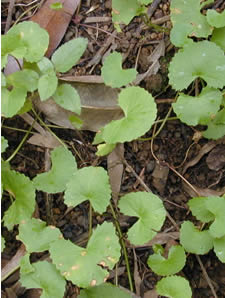Gotu Kola Centella asiatica (L.)

Gotu Kola leaves
- Common Names
- Gotu Kola , Indian Pennywort, Brahmi
- Botanical Name
- Centella asiatica (L.)
- Syn. Hydrocotyle asiatica
- Family
- APIACEAE
Medicinal Uses & Benefits of Gotu Kola
![]() How to Use|
Side Effects |
Plant & Garden|
Folklore
How to Use|
Side Effects |
Plant & Garden|
Folklore
- Medicinal Uses: * African
* Burns
* Cellulite
* Cuts & Wounds
* Eczema
* Memory/Focus
- Properties: * Antioxidant * Astringent * Cytophylactic * Hypotensive * Nervine * Refrigerant * Vasodilator * Vulnerary
- Parts Used: leaves
- Constituents: plant: asiaticoside, asiatic-acid, betulinic acid, brahminoside, kaempferol. essential oil: camphor
How to Use: Gotu Kola
Gotu kola is widely used in Ayurvedic medicine and TCM to rejuvenate both mind and body. The herb is often used in conjunction with bacopa, or Brahmi to improve mental focus and improve memory. 4
Clinical experiments have shown that the plant rejuvenates skin and body tissue by stimulating collagen synthesis. Gotu kola's constituents of primary pharmacological interest are its triterpenoids, which have been shown to exert a complex set of actions on cells and tissues, particularly connective tissues, participating in the healing process. (Duke,James, Ph.D.,119)
Gotu kola is an excellent vasodilator and blood vessel strengthener. The herb is also often used as a diuretic, antioxidant, and anti-inflammatory. This herb facilitates the actions of the antioxidant vitamins C and E in areas where there is damage.1,3
Preparation Methods & Dosage :Tea or tincture, salves, lotions and poultices. The herb tea has a light, enjoyable, slightly woody taste that is improved with lemon and a bit of honey. Fresh leaves can be eaten in salads.
Gotu Kola Remedies
Gotu Kola Side Effects: Be cautious if you are taking prescription drugs for depression, high blood pressure, or high cholesterol. Extremely large doses might cause nausea.
Plant Description

Forest & Kim Starr (USGS)
Low lying herb with umbrella like leaves that are a favorite food for elephants, Gotu Kola is part of the parsley family (and unrelated to the cola nut)and grows in tropical Africa, South America, Asia and Australia.
Regional Traditions :African *
History and Traditions & Folklore
Gotu kola got the nickname tiger's herb because injured tigers often rub against it to heal their wounds. Gotu Kola features in both Chinese and Indian myths and folklore. The Tai Chi Chuan master Li Ching-Yun purportedly lived to an advanced age of over 200 years old, due in part to his use of Gotu kola and other Chinese herbs. In Sri Lanka there is a tale of a 10th century king who claimed gotu kola (In sinhalese Gotu = conical shape and Kola= leaf), provided the energy and stamina to satisfy his extensive harem.
- Linda B. White, M.D.. "The Herbal Drugstore" Rodale, (2003) The active ingredient, asiatic acid, is particularly effective in stimulating synthesis of collagen, a prominent component of the deeper layers of skin.
- Phyllis A. Balch. "Prescription for Herbal Healing" Avery, (2002) Gotu kola is an excellent vasodilator and tones the blood vessels allowing more circulation to problem cellulite areas.
- . Centella asiatica , American Journal of Natural Medicine, (1997): Gotu kola has also been shown in a clinical trial to significantly increase mental function, demonstrating a mild tranquilizing and anti-anxiety action.,












